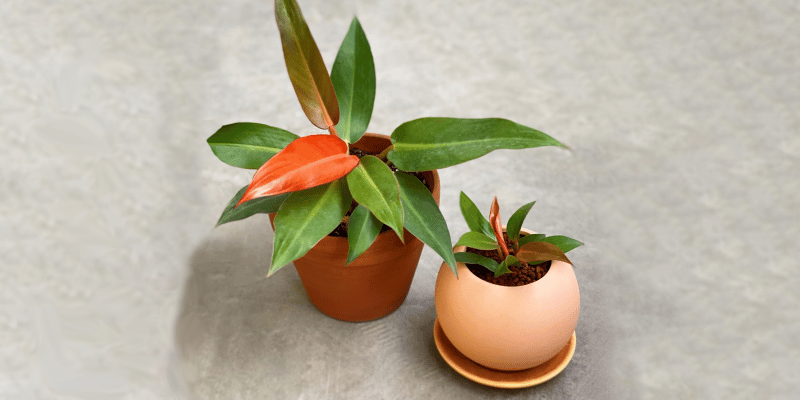Philodendron Prince of Orange is a breath of fresh orange air (at least, when its leaves are young). Its bright colors help create a cheerful, inviting atmosphere in any home or office.
For such a small plant —two feet tall max — this royal specimen packs a colorful punch!
Philodendron Prince of Orange care is pretty easy — the hardest part might be keeping humidity levels high and we have plenty of tricks for doing just that!
Let’s explore more about propagation, similar varieties, and the most common issues we see.
Table of Contents
Philodendron Prince of Orange Care Guide
History, habitat, and characteristics
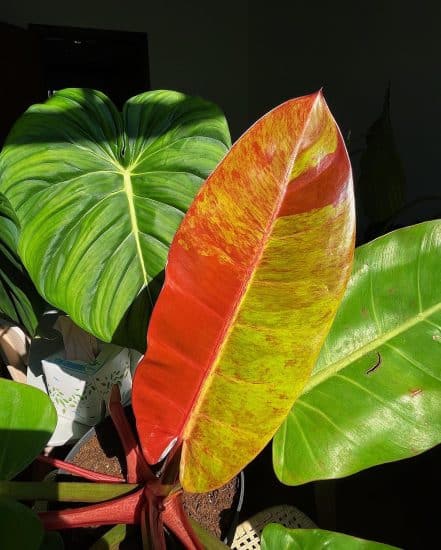
Philodendron erubescens ‘Prince of Orange’ is a hybrid variant of Philodendron erubescens (Blushing Philodendron). This means it’s related to other cultivars you might be familiar with, like Philodendron ‘Rojo’ or ‘Pink Princess’ Philodendron.
To learn more about the Prince of Orange, we have to start with a brief journey to the tropical rainforests of Colombia, where its parent Philodendron erubescens calls home.
As a climbing epiphyte, Philodendron erubescens can reach over 50 feet tall in its natural habitat, growing on trees as it seeks out light and nutrients.
The Prince of Orange plant is a fair bit more compact indoors, only growing up to a few feet tall. Yes, you can fit this beauty in your home without cutting a hole in the roof!
Philodendron means “lover of trees” in Latin, and erubescens translates to “blushing.” The ‘Prince of Orange’ moniker came from this plant’s new leaves, which pop out with a striking bright orange hue.
They’re flat and arrow-shaped, and exhibit a gentle curl on each side and end. The Prince of Orange’s leaves can sometimes look more coppery or starburst yellow as they grow, creating a range of visually appealing shades.
These colors only stay while the leaves are juvenile, however. As the plant matures, they darken to a glossy, deep green hue — which actually contrasts gorgeously with the orange and saffron shades of its younger leaves.
Did you know: There is a cultivar named Philodendron ‘Prince of Orange Variegata’ that has the same signature changing leaf color, but adds in small splashes of variegation on its orange leaves. (Be right back, adding this one to my . . . long . . . wish list!).
Similar Varieties
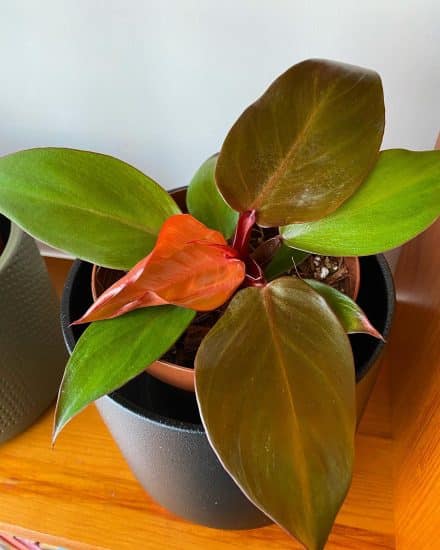
‘Prince of Orange’ can look a lot like other related Philodendron erubscens cultivars, like ‘McColley’s Finale.’ How to tell them apart? Examine the newest leaves, which will be orange on a ‘Prince of Orange,’ and red (and slightly wider) on a ‘McColley’s Finale.’
And there’s more . . . Philodendron ‘Red Sun’ is a newer variety with redder, more oval leaves that grows taller than a ‘Prince of Orange’ (up to 6 feet).
Now that you know how to tell the difference between some of the most popular varieties, let’s learn how to keep our darling Prince happy and thriving!
Light
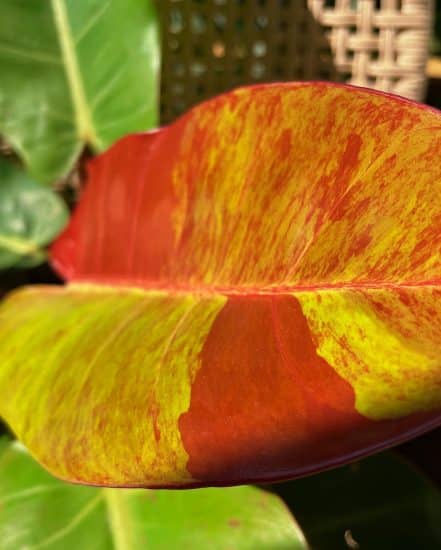
Philodendron Prince of Orange flourishes in plenty of bright, indirect light. North or east-facing windows are ideal for this plant since they get the most indirect light.
However, you can also place it in west or south-facing windows, which get direct sunlight, as long as you keep your plant farther back — at least 3 to 5 feet. If this is the case, consider using a transparent curtain to help block any direct sun, as this can damage your plant’s delicate leaves.
Speaking of too much light, be on the lookout for yellowing and curling leaves, as well as brown spots. If you see this, move it further away from the window. On the other hand, if your plant’s vibrant foliage is turning dull or pale green, that’s usually a sign it needs more light.
Finally, rotate your Prince of Orange philodendron every week or so to ensure its leaves get equal amounts of light (and you don’t get a lopsided plant).
Tip: If your plant isn’t getting enough light, you can consider adding in a grow light (LED preferred).
Water
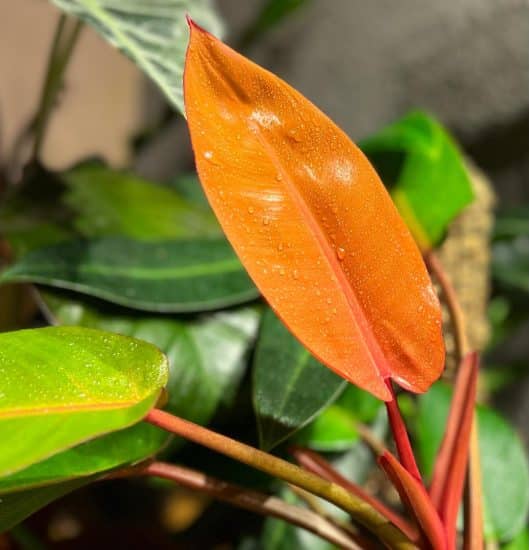
To keep its orange foliage vibrant, your Philodendron Prince of Orange needs to hit that sweet spot between enough water to stay hydrated and not so much that its roots are sopping.
You know that feeling when you step into a shower and the water’s freezing? Yeah, your plant doesn’t like it either. To avoid shocking your Orange Philodendron Prince, always use lukewarm or room-temperature water. They’ll thank you for it!
Because your plant’s water needs can depend on a whole bunch of factors, including local temperature, humidity, and pot size, it’s better not to water on a strict schedule. Instead, before you water, do a quick finger test: stick your finger into the soil one or two inches down. If it feels damp, you can skip watering that day.
When the weather is cooler, during fall and winter, your Orange Philodendron Prince will need less water than in the hotter spring and summer months.
Seeing yellowing leaves and wilting tips? You might be overwatering. Seeing brown and crispy leaves? You might be underwatering. The key is to never overwater and never let the soil get completely dry.
Tip: Tap water is okay, but try to use filtered or distilled water if you can, or even collected rainwater. These contain less salt and other chemicals that can build up in the soil and harm your plant.
Temperature and humidity
This is a tropical plant from rainforests in South America we’re talking about here. It’s not going to go skiing in its spare time. In fact, your Philodendron Prince of Orange will feel most comfortable in temperatures between 65 to 80°F (18 to 27°C).
You don’t want to let the temperature around your plant dip below 55°F (13°C), since it can’t handle those lower levels, so make sure to keep it away from cold drafts and air conditioning units.
Humidity is another big factor when it comes to keeping your Philodendron Prince of Orange healthy and vibrant: high humidity of 50% to 70% is just what the doctor ordered here.
If you can’t seem get your plant’s environment humid enough, try clustering it with other plants so they can share humidity, or putting it near a humidifier. You can also place it on top of a pebble tray filled with water. When the water evaporates, humidity around your plant will increase about 4% or 5%, but not your whole house (win-win!).
Soil and planting
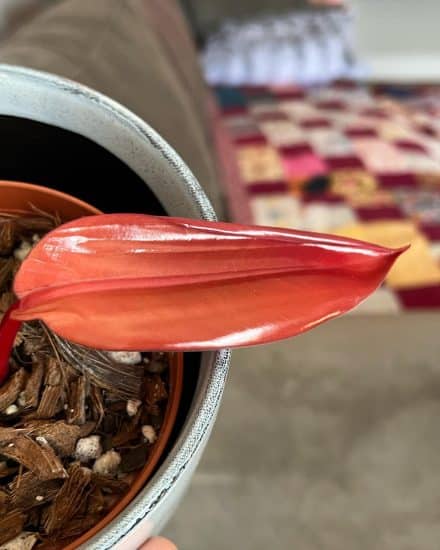
Philodendron Prince of Orange needs a well-draining soil mix with a pH somewhere between 6 and 7, so slightly acidic to neutral. You can buy an aroid potting mix, or feel free to experiment and create your own.
An ideal combo could look something like:
- 40% orchid bark (promotes both drainage and moisture retention)
- 30% potting soil (provides support and essential nutrients)
- 20% sphagnum moss or peat moss (helps with drainage)
- 10% perlite (helps aerate and drain)
You can experiment and discover what works best for your plant and its specific environment. Although the exact percentages might change, as an epiphyte, ‘Prince of Orange’ will thrive in a bark-based mix with plenty of chunky pieces (like coco coir, for instance) to help with drainage and moisture retention.
Tips: You can add in some horticultural charcoal to give the soil a nutrient and mineral boost. Does your potting mix need more aeration? Use a bit of LECA to create air pockets in the soil.
Pruning
Like you’d do with other Philodendron plants, prune off dead or diseased leaves with clean shears or scissors. You can also prune your plant to make it grow bushier, although you likely won’t need to do that with this one, since the Prince of Orange doesn’t get that tall to begin with.
Repotting
Orange Philodendrons will need repotting every year or two, or when it becomes rootbound. Use a pot only 1 to 2 inches larger with enough drainage holes (one or more) to prevent root rot. The best time to repot is during the spring and summer growing months.
Fertilizing
Fertilize your plant with a 50% diluted balanced liquid houseplant fertilizer every month in spring and summer. Don’t fertilize your Philodendron Prince at all in the winter months, since it won’t be growing then and will be unable to take up the nutrients. Fertilizing while it’s dormant could actually harm your plant.
Propagation guide
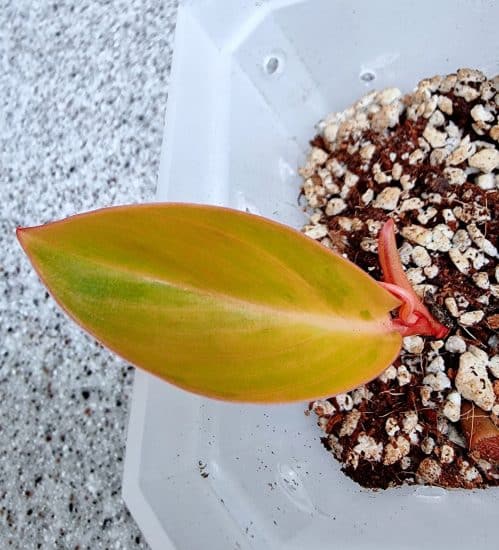
So you want to propagate Prince of Orange? You’re in for an easy ride. There are two main ways to do it:
- Placing stem cuttings in soil or water is simple with reliable results. (Optional: Instead of soil, use LECA. Because Prince of Orange cuttings tend to be heavier, LECA can help stabilize them).
- Air layering in sphagnum moss and perlite takes only a little more effort and supercharges growth.
To propagate Philodendron ‘Prince of Orange’ by stem cuttings:
- Select a healthy stem cutting at least 4 inches long and pluck off any leaves near its base.
- Use clean scissors or shears to make a cut just below an aerial node.
- Place the cutting directly in a small jar of water or pot with moist soil mix, in an area with bright light. In in a pot, keep soil moist but not saturated. Now all you have to do is wait for roots to grow.
- If the cutting is in water, change the water every few days. Make sure the nodes stay submerged. After roots have grown a few inches, carefully transfer the cutting to a pot filled with soil mixture.
Keep the plant watered and healthy, and soon you’ll have a whole other thriving Philodendron ‘Prince of Orange’ (and who couldn’t use more of those?).
To propagate Philodendron ‘Prince of Orange’ by sphagnum moss and perlite: You need aerial roots for this air layering method. Cut right below a node, wrap damp sphagnum moss around the cutting, and cover it with a plastic bag to trap humidity for several weeks while you wait for roots to grow.
Propagating is such fun, but what happens when Prince of Orange pests and brown leaves show up to the party? We politely disinvite them.
Common issues
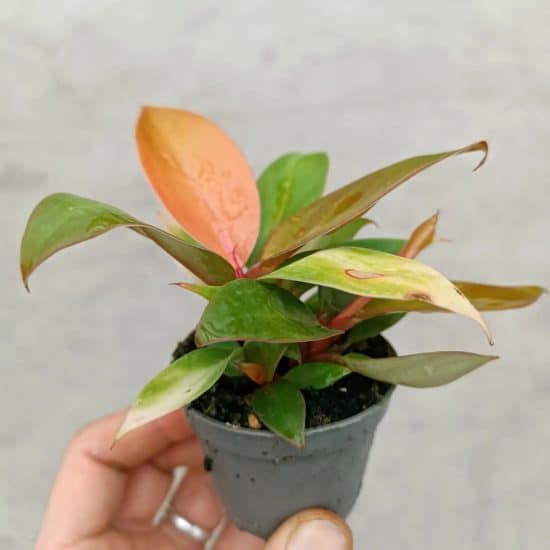
The vast majority of issues that come up with the Prince of Orange plant (and most plants, for that matter), stem from the wrong amount of light or water.
Brown tips
This is a common issue for the Prince of Orange — low humidity levels can cause brown leaf tips and edges. (This could be a sign of underwatering, but 99% of the time, it means your plant needs more humidity).
What to do? Use a humidifier or a pebble tray.
Leaves turning yellow
Yellowing leaves happen when your plant is getting too much direct sunlight, or the wrong amount of water. If you suspect your plant is getting too much sunlight, move it a few feet away from the window. Only water when the soil is dry one or two inches down. Think moist but not sopping wet.
Leaves wilting
Wilting might mean your plant is thirsty. If you think this might be the case, check the soil. If it’s dry, time to water. If not, you may have overwatered. Put the plant in fresh, dry soil and don’t water it for a bit while it recovers.
Diseases and pests
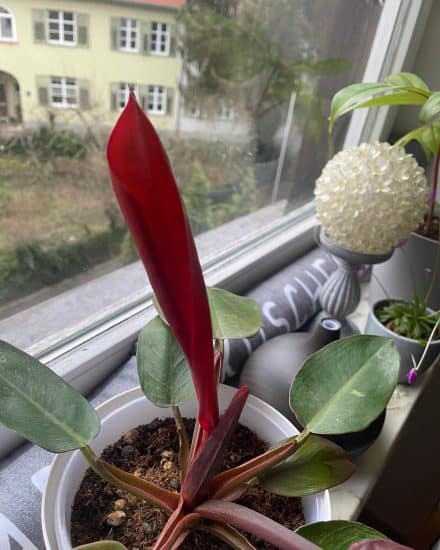
Root rot is a common problem for Philodendron Prince of Orange, like it is for most plants. Fungus and bugs can strike too. We’ll explain how to defeat them all.
Root rot
Rotting roots happen when the plant’s soil is too wet, depriving the roots of oxygen. Signs that your Prince of Orange may be suffering from root rot include wilting or yellowing leaves, brown spots on the foliage, and smelly or black roots.
Solution: Cut off any affected roots, disinfect the pot in bleach and water, and repot the plant in fresh soil. Let the soil completely dry out before watering.
Fungus
Fungal leaf spot or powdery mildew is also something to watch out for with Prince of Orange plants. Does yours have black or brown dead areas on the leaf? That’s likely fungal leaf spot. White spots or a white, powdery coating on its leaves? That’s powdery mildew.
Solution: It may be time to break out the fungicide. Cut off any affected plant parts first. You can try a more gentle option at first by spraying your plant with a combination of baking soda and water (1 teaspoon of baking soda per quart of water), which can help stop the spread.
Bugs
Tiny pests may stop by your Prince of Orange every now and then. Aphids, fungus gnats, or mealybugs are the usual suspects.
Solution: If you spy any, isolate your plant from others if possible so the bugs don’t spread. You can take care of them with diluted neem oil or insecticidal soap, and a light spritz of water on leaves (top and bottom sides) and stems to wash away their hiding spots.
Conclusion
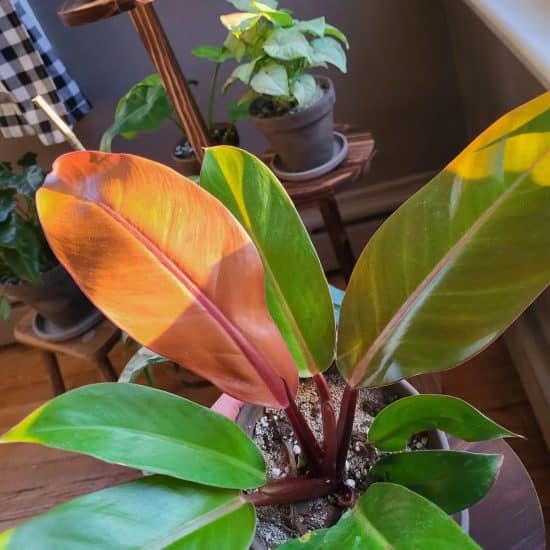
Philodendron Prince of Orange is a three-for-one, with vivid orange foliage, minimal space requirements, and low-maintenance care. It grows much smaller indoors than in its natural environment.
This plant thrives in normal household temperatures, bright indirect sunlight, and moderate to high humidity levels. Keep it in these ideal conditions, and you’ll see leaves change from copper and yellow to green as they grow.
Propagate for friends and get more of these orange delights out into the world!
If you found this article helpful, share it with a fellow Prince of Orange-owning friend! Did you snag one? Send us a pic (we’re not jealous at all, we promise)!
FAQ
Is Prince of Orange rare?
Compared to other philodendron varieties, Prince of Orange is relatively rare, but it’s gradually becoming more accessible at nurseries and plant shops. You can always find it online as well.
How much light does a Prince of Orange need?
This plant likes a lot of bright light, as long as it’s indirect. Direct sunlight can burn its leaves, and nobody wants a burnt Orange.
Is Prince of Orange an indoor plant?
Prince of Orange is ideally suited for being indoors because of its compact growth. It only gets up to two feet tall, so it’s perfect for smaller spaces.
Does Prince of Orange like humidity?
Yes, the more, the better! These guys — ahem, princes — are tropical plants, so they thrive in humidity levels of 50 to 70%.

